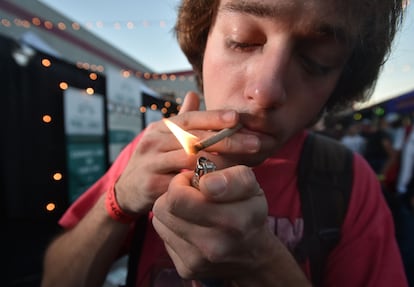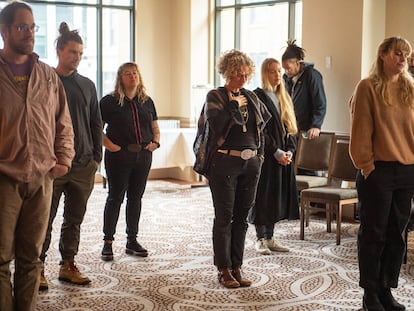Oregon’s drug decriminalization gets poor marks on audit
Decriminalization of personal-use amounts of drugs was approved by voters in 2020 under Ballot Measure 110

Oregon’s first-in-the-nation drug decriminalization has had a rocky start, but Secretary of State Shemia Fagan said Thursday in releasing an audit of the program that it’s too early to call it a failure.
Decriminalization of personal-use amounts of drugs, approved by voters in 2020 under Ballot Measure 110, was supposed to channel hundreds of millions of dollars of marijuana tax revenues into drug treatment and harm reduction programs. But that hasn’t yet translated into an improved care network for a state with the second-highest rate of substance use disorder in the nation and ranked 50th for access to treatment.
“When Oregonians passed Measure 110, we expected that our loved ones battling addiction would have access to treatment and a chance for a better life,” Fagan told reporters in a Zoom press conference. “We expected there will be fewer of our neighbors struggling on the streets.”
Instead, the funding has been slow getting out of the gate and instances of drug abuse and overdose deaths have increased.
Other states that might consider following Oregon’s path – which a few countries including Portugal have taken – will likely assess how well, or badly, it has gone. Portugal’s approach, though, is more vigorous than Oregon’s in getting people to treatment. There, “dissuasion commissions” pressure anyone caught using drugs to seek treatment.
Asked in the news conference what grade he would assign Oregon’s program thus far, auditor Ian Green said “maybe a C.” Audits Director Kip Memmott gave it a D and Fagan said she’d assign an “incomplete.”
The director of the Oregon Health Authority, which helps establish the measure’s drug treatment aspects, blamed the funding delays on “ambitious implementation timelines and stretched OHA staffing resources due to the pandemic,” along with a shift in decision-making roles that required building new relationships.
“I recognize that Measure 110′s success depends on Oregon’s ability to solve many larger challenges in the behavioral health system, such as the need to expand treatment capacity and better support counselors and other workers,” said OHA Director James Schroeder, who was appointed this month by recently elected Gov. Tina Kotek.
Schroeder said Kotek has made improving Oregon’s behavioral health system and Measure 110 implementation a top priority.
Among the audit’s recommendations: The health authority should publish a plan by September on integrating Measure 110 into the state’s overall behavioral health system; improve data collection so the ballot measure’s effectiveness can be tracked by policymakers and the public; and set clear expectations, roles and responsibilities.
Another setback of the measure is the lack of people with substance abuse disorders who are seeking help after being ticketed for drug possession and given a hotline number.
In the first year after the new approach took effect in February 2021, only 1% of people who received citations for possessing controlled substances sought help via the new hotline.
Keith Humphreys, an addiction researcher and professor of psychiatry at Stanford University, said the audit “is commendably candid in acknowledging the bureaucratic failures that produce insufficient and uncoordinated services, and the reforms proposed to fix that situation are sensible.”
“In contrast, the report does not deal adequately with that fact that the statewide effort to use tickets/fines for drug possession to incentivize people to enter treatment was a complete failure,” Humphreys, a former senior adviser in the White House Office of National Drug Control Policy, said in an email.
Oregon officials are wrong to assume that increasing access to treatment alone will lead to most addicted individuals seeking drug treatment, he said.
“Without some external pressure, most people will not attempt to reduce their drug use via treatment or other means,” Humphreys said.
The Drug Policy Alliance, which spearheaded Oregon’s ballot measure, intentionally sought an approach that did not compel people to seek treatment, saying there are more successful outcomes when people voluntarily access services.
Fagan, whose brother and late mother had drug dependency issues, said the old system of criminalizing drug possession, combined with a lack of available treatment, simply did not work.
“I was one of the strong majority of Oregon voters who voted for Measure 110 because the status quo had failed my family and people who I love,” Fagan said. She described how she and another brother some four years ago tried to find somewhere to take their sibling after he was ready to get treatment.
“My other brother and I called all over, and we couldn’t find an inpatient facility to take him, despite the fact that he had really hit rock bottom,” Fagan said, adding that her brother is now successfully undergoing treatment.
“Make no mistake, this is a matter of life and death,” Fagan said. “Measure 110 must work because real people’s lives hang in the balance.”
Tu suscripción se está usando en otro dispositivo
¿Quieres añadir otro usuario a tu suscripción?
Si continúas leyendo en este dispositivo, no se podrá leer en el otro.
FlechaTu suscripción se está usando en otro dispositivo y solo puedes acceder a EL PAÍS desde un dispositivo a la vez.
Si quieres compartir tu cuenta, cambia tu suscripción a la modalidad Premium, así podrás añadir otro usuario. Cada uno accederá con su propia cuenta de email, lo que os permitirá personalizar vuestra experiencia en EL PAÍS.
¿Tienes una suscripción de empresa? Accede aquí para contratar más cuentas.
En el caso de no saber quién está usando tu cuenta, te recomendamos cambiar tu contraseña aquí.
Si decides continuar compartiendo tu cuenta, este mensaje se mostrará en tu dispositivo y en el de la otra persona que está usando tu cuenta de forma indefinida, afectando a tu experiencia de lectura. Puedes consultar aquí los términos y condiciones de la suscripción digital.
More information
Archived In
Últimas noticias
Aquilino Gonell, former Capitol sergeant: ‘If it hadn’t been for the police, the US would be a dictatorship’
A hybrid building: Soccer pitch, housing, and a shopping mall
Europe urges Trump to respect Greenland following annexation threats
Science seeks keys to human longevity in the genetic mixing of Brazilian supercentenarians
Most viewed
- Alain Aspect, Nobel laureate in physics: ‘Einstein was so smart that he would have had to recognize quantum entanglement’
- Mexico’s missing people crisis casts a shadow over World Cup venue
- Why oil has been at the center of Venezuela-US conflicts for decades
- Alvin Hellerstein, a 92-year-old judge appointed by Bill Clinton, to preside over Maduro’s trial in New York
- Cuba confirms death of 32 of its citizens in the US attack against Venezuela










































